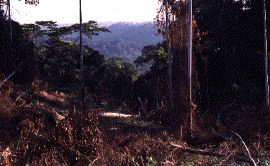
Amazon Interactive
Making a Living
Indigenous peoples have lived in the Amazon for thousands of years. For most of that time, they hunted, fished, and grew a variety of crops in small gardens. Their lifestyle was called subsistence, because they hunted and grew only what they needed to subsist, or survive. They practiced a kind of agriculture called slash and burn.

In the Ecuadorian Amazon, indigenous Quichua people often rotate their crops every year. That way their crops always have rich soil. Also, after a year in cultivation, a field becomes overgrown with weeds.
Watch the animation below to see how a Quichua farmer might rotate his cropsover the years to ensure good yields on his land. Each year he clears and plants a new section of land, leaving the old section to regrow as secondary forest.
When you see the ?, it's your turn to decide where to plant crops for the coming year. Click on the section of land you would clear next.
|
 |
| Primary Forest | Secondary Forest Lower Left |
Secondary Forest Lower Right |
Subsistence Cropland |
Would you like to learn more about the crops or animals that you'd eat in the Amazon?
